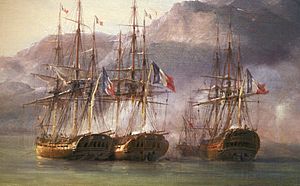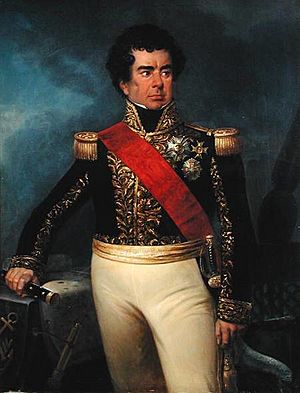Action of 3 July 1810 facts for kids
Quick facts for kids Action of 3 July 1810 |
|||||||
|---|---|---|---|---|---|---|---|
| Part of the Napoleonic Wars | |||||||
 Ceylon (far right) at the Battle of Grand Port |
|||||||
|
|||||||
| Belligerents | |||||||
| Commanders and leaders | |||||||
| Strength | |||||||
| 2 frigates 1 brig |
3 merchantmen | ||||||
| Casualties and losses | |||||||
| 22 killed 38 wounded |
20 killed 76 wounded 2 merchantmen captured |
||||||
The action of 3 July 1810 was a small but important naval battle. It happened during the Napoleonic Wars in the Indian Ocean. A French group of warships, led by Guy-Victor Duperré, attacked a convoy of British merchant ships. These ships belonged to the Honourable East India Company.
The British ships fought bravely and many sailors were hurt. However, two ships were eventually captured by the French. These were the Windham and the Ceylon. The Windham fought hard to let another ship, the Astell, get away.
This battle was the third time in a year that French ships had successfully attacked British convoys in the Indian Ocean. The French warships were based at Île de France. They were part of a group led by Commodore Jacques Hamelin.
The British wanted to stop these French attacks. Commodore Josias Rowley was supposed to deal with the French raiders. But he was busy planning to invade Île Bonaparte, another French island. This invasion happened the week after the battle. Because the British had limited ships, the French could attack British trade freely.
However, capturing French bases was a key British plan. The successful invasion of Île Bonaparte greatly limited future French attacks. Hamelin's ships were then needed to defend Île de France. This battle was the last successful French attack on a British merchant convoy in the Indian Ocean during the Napoleonic Wars.
Contents
Why This Battle Happened
Since the Napoleonic Wars began in 1803, French ships had been attacking British trade. These ships were often privateers (private ships allowed to attack enemy shipping) or naval frigates (fast warships). They operated from strong island bases like Île de France and Île Bonaparte.
The Indian Ocean is huge, and supplies were hard to get. Also, the Royal Navy and large, armed East Indiamen (merchant ships) were present. This made it hard for the weaker French ships to attack big convoys. These convoys carried millions of pounds worth of goods from British India to the United Kingdom. In 1805, a French group tried to capture a convoy but was driven off by the brave merchant captains.
In late 1808, the French Navy sent five frigates to the Indian Ocean. They were to meet at Île de France under Commodore Jacques Hamelin. Only four frigates arrived, but they were new ships with 40 heavy guns each. Their mission was to attack British shipping, especially the large East Indiamen.
The first French frigate to succeed was the Caroline. She attacked a convoy in May 1809. Caroline captured two East Indiamen carrying over £500,000 worth of silk. She brought her captured ships back to Saint Paul on Île Bonaparte.
The British commander, Albemarle Bertie, also planned operations in the Indian Ocean. He put Commodore Josias Rowley in charge of a group of ships. Rowley's orders were to block the French islands and capture them if possible. Rowley found his small group of ships could not fight the French frigates easily. The nearest British military base, Madras in British India, was too far away for launching attacks.
To fix this, Rowley captured the small French island of Rodriguez. He used British and Indian soldiers to set up a supply base there. This base also served as a place to gather troops for future landings on the French islands.
French Ships Keep Attacking
Even after the British attacked Saint Paul, French frigates kept operating. Commodore Hamelin himself led a trip in the Bay of Bengal. His ships captured several small merchant vessels. In November 1809, he personally captured three large East Indiamen. Before returning to Île de France, his group also captured a British brig (a small warship) and a large Portuguese frigate.
During the winter, few ships sailed because of the risk of hurricanes. Rowley moved most of his ships to the Cape of Good Hope. He left only a few smaller ships to watch the French islands. Hamelin also kept his ships in harbor at Île de France. He repaired his ships and found new sailors from the many unemployed men in Port Napoleon.
In March, Hamelin sent a group of ships to sea. This group included the large frigate Bellone, the captured Minerva (now called Minerve), and the captured brig Victor. Guy-Victor Duperré led this group on Bellone. Pierre Bouvet was his second-in-command on Minerve.
Duperré's ships avoided the British blockade and sailed unnoticed. They began cruising in the Bay of Bengal. They captured a few small ships but did not greatly affect British trade there. By June, Duperré had moved to the Western Indian Ocean, near Madagascar. He hoped to find British ships coming from Cape Town. His ships needed repairs after being at sea for so long. He spent much of July fixing them at quiet beaches.
The Battle Begins
On July 3, at 6:00 AM, Duperré's ships were near the small island of Mayotta. They saw sails about 36 nautical miles (67 km) to the northeast. Duperré immediately chased them. He discovered they were a convoy of three large East Indiamen: Ceylon, Windham, and Astell. Captain Henry Meriton commanded Ceylon.
Meriton was a very experienced captain. He had successfully defended his convoys from French raiders twice before. In 1800, his ship Exeter had even forced a French frigate to surrender. The convoy had left Cape Town on June 13 with five ships. But two had to turn back after one hit a rock. The others continued their journey to Madras.
One of the East Indiamen, Windham, had been captured by Hamelin in November 1809. She was recaptured a month later by a British warship. Duperré's three ships had 108 guns and trained naval crews. The British East Indiamen had about 75 cannon between them. Only a few of their sailors were trained for battle. Most of their crews were lascar seamen, who had not always fought well in past battles.
However, the British merchant ships were large. They also had 250 soldiers from the 24th Regiment of Foot on board. These soldiers were traveling to India. They could fire muskets and stop French sailors from boarding their ships.
Duperré was confident his ships were stronger. He ordered his ships to chase the East Indiamen. The British ships tried to get closer to the shore. This would make the wind and waves less strong, helping them resist the French attack. But by 9:30 AM, the Astell had to slow down to avoid breaking her masts. This slowed the whole British convoy.
Realizing he could not outrun Duperré, Meriton decided to turn his ships and fight. At 11:30 AM, Bellone was only 4 nautical miles (7.4 km) away. Meriton ordered his ships to form a battle line to meet the French.
Fighting at Sea
The French attacked at 2:15 PM. Minerve approached the British line and fired at Ceylon, the middle ship. The British battle line had become messy, with Astell too far back to help properly. As the British line struggled, Minerve and Victor moved closer. They began exchanging fire with the three merchant ships. During this general fight, Robert Hay, captain of Astell, was badly wounded.
At 4:00 PM, Bouvet in Minerve moved ahead of the British convoy. He turned as if to ram and board Windham. Captain Stewart of Windham turned to meet her, hoping to use his soldiers to drive off the French ship. But Windham was too damaged to turn correctly. Minerve passed just in front of her, firing along Windham's length. This caused severe damage. The soldiers on Windham fired back with muskets.
As Minerve turned back, Astell moved past her damaged companions. She became the first ship in line. This left Windham alone at the rear to face Minerve. Luckily for Stewart, Minerve lost two topmasts as she turned. She had to pull away to make repairs.
An hour and a half later, at 6:30 PM, Bellone joined the fight. She attacked Windham directly. Victor supported Bellone as they moved to attack Ceylon and Astell. By 7:00 PM, Ceylon was so badly damaged she could no longer sail or fight. Her third officer ordered the crew to stop firing. Meriton and his second officer had both been seriously wounded by grape shot (small metal balls fired from cannons).
With Ceylon out of the fight, Duperré moved to attack Astell. But Stewart had brought his damaged Windham between the French frigate and Astell. In the growing darkness, Stewart tried to signal Astell to suggest boarding Bellone together. But Astell's officers either did not hear or ignored him. Astell turned off all her lights and sailed away as fast as she could. She received one last volley of cannon fire from Bellone as she left.
Alone, Stewart continued to fight the French ships. He wanted to give Astell more time to escape. At 7:20 PM, the repaired Minerve returned and captured Ceylon. At 7:45 PM, Stewart surrendered for the second time in less than a year. His ship was badly damaged, and many of his crew and passengers were hurt.
After the Battle
Astell was the only British East Indiaman to escape. She disappeared in the darkness and later reached a safe port. From there, messages were sent to London telling about the battle. Because of their bravery, the crew and officers of Astell received £2,000 from the company directors.
The British ships had many casualties. Windham lost six killed and 18 wounded. Ceylon lost six killed and 21 wounded (including Captain Meriton). Astell lost eight killed and 37 wounded (including Captain Hay). In total, 20 British sailors and soldiers were killed and 76 wounded. The French also had losses: 22 killed and 38 wounded.
The captured ships were very badly damaged. Duperré had to take his ships to a quiet beach on Anjouan until July 17 to make repairs. Then he returned to Île de France. Command of Ceylon, renamed Ceylan, was given to a French lieutenant. Command of Windham was given to a French ensign.
Duperré did not meet any British ships on his way back to Île de France. Most of the British ships were busy after the Invasion of Île Bonaparte. This invasion was led by Commodore Rowley in July. While the British were busy, Duperré easily reached Grand Port on the southeast coast of Île de France. This harbor was narrow and well-protected. It was considered the best place to repair the damaged French ships.
However, in August, a British group of ships attacked Grand Port in the Battle of Grand Port. This battle was a disaster for the British. Their ships got stuck in the shallow waters of the harbor. Four frigates were lost under fire from shore defenses and Duperré's ships.
Images for kids
-
Ceylon (far right) at the Battle of Grand Port




